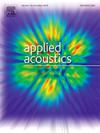Influence of different excitation parameters on laser ultrasonic Rayleigh wave and surface micro-defect detection
IF 3.4
2区 物理与天体物理
Q1 ACOUSTICS
引用次数: 0
Abstract
Ultrasonic Rayleigh wave excited by laser can be used to detect surface defects. However, the change of the parameters of the excitation laser will lead to change in the time–frequency characteristics of the Rayleigh wave, which in turn affects the detection of micro surface defects. Through numerical simulation and experiments, this paper systematically studied the influence laws of excitation laser pulse energy, pulse width, spot diameter on ultrasonic Rayleigh wave amplitude in time domain and maximum effective frequency in frequency domain, established three-dimensional finite element models of laser ultrasonic detection of surface micro-defects, and revealed that with the increase of Rayleigh wave frequency, the transmitted energy decreases after the interaction of Rayleigh waves and defects. The ultrasonic detection experiment for surface micro-defects is designed. In the experiment, the excitation laser is picosecond pulsed laser, and the B-Scan images of Φ0.1 mm and Φ0.05 mm micro-defects under different excitation laser parameters were obtained. The laser ultrasonic fast scanning detection system based on two-dimensional galvanometer was established to detect Φ0.05 mm defects on the surface of additive titanium alloy plate by C-Scan imaging. The micro-defects on rough surface were successfully detected under the optimal detection parameters. The research results provide a basis for the design and optimization of laser ultrasonic detection parameters of surface micro-defects.
求助全文
约1分钟内获得全文
求助全文
来源期刊

Applied Acoustics
物理-声学
CiteScore
7.40
自引率
11.80%
发文量
618
审稿时长
7.5 months
期刊介绍:
Since its launch in 1968, Applied Acoustics has been publishing high quality research papers providing state-of-the-art coverage of research findings for engineers and scientists involved in applications of acoustics in the widest sense.
Applied Acoustics looks not only at recent developments in the understanding of acoustics but also at ways of exploiting that understanding. The Journal aims to encourage the exchange of practical experience through publication and in so doing creates a fund of technological information that can be used for solving related problems. The presentation of information in graphical or tabular form is especially encouraged. If a report of a mathematical development is a necessary part of a paper it is important to ensure that it is there only as an integral part of a practical solution to a problem and is supported by data. Applied Acoustics encourages the exchange of practical experience in the following ways: • Complete Papers • Short Technical Notes • Review Articles; and thereby provides a wealth of technological information that can be used to solve related problems.
Manuscripts that address all fields of applications of acoustics ranging from medicine and NDT to the environment and buildings are welcome.
 求助内容:
求助内容: 应助结果提醒方式:
应助结果提醒方式:


